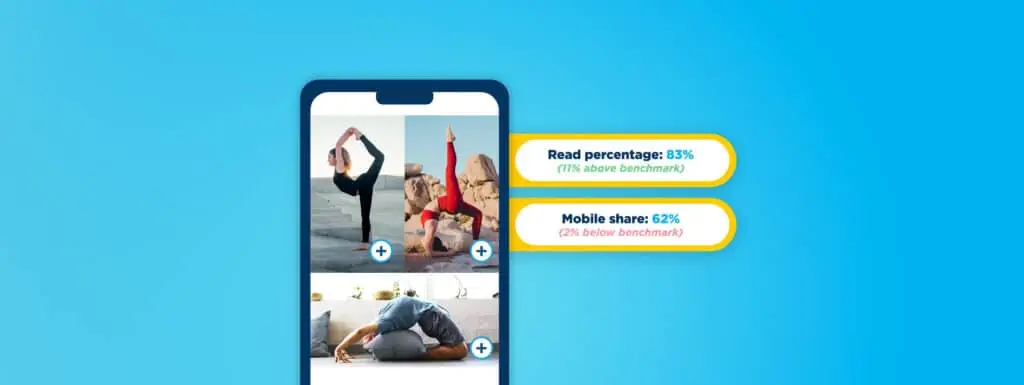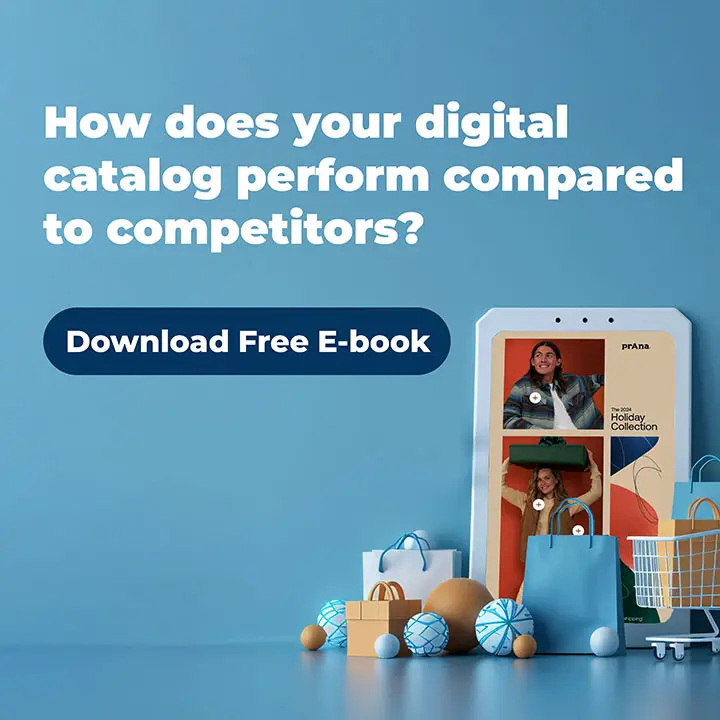Wondering how your digital flyer and catalog statistics compare to others in your industry? Check out these industry benchmarks based on engagement to understand how you’re doing.
Industry benchmarks are pivotal in providing businesses with a comprehensive understanding of their campaign performance and industry standards. They serve as vital metrics that enable businesses to gauge the effectiveness of their digital flyer and/or catalog strategy.
By comparing key performance indicators (KPIs) such as readership percentage, average engagement time, and bounce rate, retail businesses can identify areas of strength and weakness in their campaigns while measuring their performance against competitors and industry leaders. These industry benchmarks can provide you with a baseline against which your organization can set targets for improvements and measure the success of your optimization efforts.
Average Digital Publication Industry Benchmarks
The data below is from January 1st to March 31st, covering the first quarter of 2024.
We only included industries with at least 300 publications (can go up to 6k+) and at least 500k opens/reach (can go up to 100M).
| Industry | Average publication size (pages) | Read percentage | Average engagement time/publication (minutes) | Average engagement time/page (seconds) | Average bounce rate | Mobile share |
| Beauty | 27.7 | 53.3% | 3 | 12.1 | 23.6% | 90.6% |
| Consumer Goods | 58.5 | 54.4% | 5.5 | 10.3 | 25.6% | 78.1% |
| DIY/Equipment | 55.5 | 18.3% | 3.5 | 20.7 | 39.2% | 78.8% |
| Electronics | 18.2 | 87.8% | 4.8 | 17.9 | 29.6% | 42.4% |
| Fashion / Apparel | 67 | 81.2% | 7.3 | 8 | 21.2% | 75.1% |
| Food & Beverages | 29.3 | 83.4% | 4.6 | 11.3 | 22.8% | 78.2% |
| Home & Living | 46.8 | 24.7% | 2.5 | 12.8 | 46% | 79.9% |
| Manufacturing & Distributing | 40.4 | 33.5% | 4.8 | 21.4 | 52.6% | 25.1% |
| Sports & Outdoor | 62.5 | 59.9% | 6.5 | 10.2 | 24.4% | 62.6% |
| Wholesale | 26.2 | 59.1% | 3.1 | 11.9 | 41.5% | 59% |
METRIC LEGEND
Average publication size (pages): average # of single pages in a publication.
Read percentage: average pages viewed per visit over the average # of pages per publication.
Average engagement time/publication (minutes): average time a publication is viewed per visit in minutes.
Average engagement time/page (seconds): average time a page is viewed per visit in seconds.
Average bounce rate: percentage of publication opens with no additional interactions.
Mobile share: percentage of opens on mobile; the rest will (mostly) be on desktop devices.
How Can You Use Publitas Industry Benchmarks To Improve?
These metrics are just a starting point! We can help you analyze them better based on your own context, goals, and metrics.
A few examples of what to look out for:
- Consider your read percentage. You want to aim for a high number here, as too low would mean you are spending time creating content readers don’t even get to explore. You can dive deeper to see if your readers view just the first few pages and drop off, or navigate to the areas of interest throughout the publication. You might want to consider breaking up your content and publishing more regularly or at least maximizing space by showing only in-stock products. However, if it’s very high, you might have room to add a few more pages and promote additional products that could then drive a higher sales figure!
- Most industries show a high mobile share. Do you see that for your publications too? How have you adapted your content and promotion to capture this audience? For example, ensure text sizes are at least 20pts, place text details behind pop-up interactions, and consider vertical scroll navigation (much more intuitive on mobile devices).
The metrics here are just a snapshot of what we can help you measure and optimize. Beyond engagement, increasing your reach (in B2C) and conversion numbers is just as key. Our team of experts can help you improve.
Success stories optimizing their engagement, conversion, and reach metrics with Publitas
Here are a few examples of how businesses have leveraged their digital catalogs to reach their goals.
Capitol Lighting
Capitol Lighting, a US home & living business, observed a remarkable 22% increase in average order value (AOV) among viewers who engaged with the digital catalog compared to those who solely browsed their e-commerce website. Last summer, they measured an average engagement time of 6 minutes and 16 seconds—a testament to the captivating, interactive content, which is well above the industry average.
In particular, the catalog design uses dynamic product placement from their integrated product feed. This approach offers them greater flexibility in product positioning and overall page design. As a result, Capitol Lighting has eliminated the need to collaborate with external agencies for PDF creation.
Coulisse
Coulisse, a Dutch manufacturer, leveraged Publitas to create a mobile-first interactive design, allowing readers to order their swatches directly from the catalog. Their customers expressed satisfaction with the accessibility and the user-friendly interface of their online catalog, appreciating the convenience of browsing through the offerings and highlighted the efficiency in finding relevant information.
“We have observed increased engagement metrics, with users spending extended periods exploring the content available. The extended reading time could indicate the engaging nature of our online catalog, suggesting that customers find value in the presented information.”
Optronics
Optronics, a US electronics wholesaler, leveraged Publitas’s advice to transform their 750+ page catalog into an engaging content asset. They saw a 300% increase in page views through a custom menu and search bar to solve their customers’ product discovery challenge. Post-implementation data showed that engagement levels improved dramatically as 40% of users who opened the catalog interacted with the custom menu, while 8% used the custom search bar to locate specific items.
The added benefit is that the reach increased by 212.5% in just a month, and Optronics was able to reduce 50% of its budget allocated to catalogs by using these design optimizations, as the need to create lengthy lists and indexes was dramatically reduced.
Wonder where you stand? And how you could optimize your results?
- Assess your content’s data through Publitas analytics dashboards or third-party integrations.
- Compare where you stand with your industry, and take inspiration from other businesses.
- Outline an optimization strategy.
- Action changes and leverage A/B testing to measure the results.
You can do this yourself or reach out to us to help you analyze and outline a custom optimization plan based on the best practices we see industry leaders adopt.


